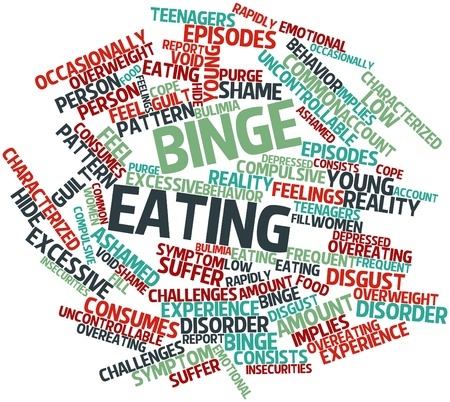Eating is controlled by many factors, including appetite, food availability, family, peer, and cultural practices, and attempts at voluntary control. Dieting to a body weight leaner than needed for health is highly promoted by current fashion trends, sales campaigns for special foods, and in some activities and professions.
Eating disorders involve serious disturbances in eating behavior, such as extreme and unhealthy reduction of food intake or severe overeating, as well as feelings of distress or extreme concern about body shape or weight. Researchers are investigating how and why initially voluntary behaviors, such as eating smaller or larger amounts of food than usual, at some point move beyond control in some people and develop into an eating disorder. Studies on the basic biology of appetite control and its alteration by prolonged overeating or starvation have uncovered enormous complexity, but in the long run have the potential to lead to new pharmacologic treatments for eating disorders.
Eating disorders are not due to a failure of will or behavior; rather, they are real, treatable medical illnesses in which certain maladaptive patterns of eating take on a life of their own. The main types of eating disorders are anorexia nervosa and bulimia nervosa. A third type, binge-eating disorder, has been suggested but has not yet been approved as a formal psychiatric diagnosis.
Eating disorders frequently develop during adolescence or early adulthood, but some reports indicate their onset can occur during childhood or later in adulthood.Eating disorders frequently co-occur with other psychiatric disorders such as depression, substance abuse, and anxiety disorders. In addition, people who suffer from eating disorders can experience a wide range of physical health complications, including serious heart conditions and kidney failure which may lead to death. Recognition of eating disorders as real and treatable diseases, therefore, is critically important.
Females are much more likely than males to develop an eating disorder. Only an estimated 5 to 15 percent of people with anorexia or bulimia and an estimated 35 percent of those with binge-eating disorder are male.
Anorexia Nervosa
An estimated 0.5 to 3.7 percent of females suffer from anorexia nervosa in their lifetime.1 Symptoms of anorexia nervosa include:
- Resistance to maintaining body weight at or above a minimally normal weight for age and height.
- Intense fear of gaining weight or becoming fat, even though underweight.
- Disturbance in the way in which one’s body weight or shape is experienced, undue influence of body weight or shape on self-evaluation, or denial of the seriousness of the current low body weight.
- Infrequent or absent menstrual periods (in females who have reached puberty).
People with this disorder see themselves as overweight even though they are dangerously thin. The process of eating becomes an obsession. Unusual eating habits develop, such as avoiding food and meals, picking out a few foods and eating these in small quantities, or carefully weighing and portioning food.
Persons with anorexia may repeatedly check their body weight, and many engage in other techniques to control their weight, such as intense and compulsive exercise, or purging by means of vomiting and abuse of laxatives, enemas, and diuretics. Girls with anorexia often experience a delayed onset of their first menstrual period.
The course and outcome of anorexia nervosa vary across individuals: some fully recover after a single episode; some have a fluctuating pattern of weight gain and relapse; and others experience a chronically deteriorating course of illness over many years.
The mortality rate among people with anorexia has been estimated at 0.56 percent per year, or approximately 5.6 percent per decade, which is about 12 times higher than the annual death rate due to all causes of death among females ages 15-24 in the general population. The most common causes of death are complications of the disorder, such as cardiac arrest or electrolyte imbalance, and suicide.
Bulimia Nervosa
An estimated 1.1 percent to 4.2 percent of females have bulimia nervosa in their lifetime. Symptoms of bulimia nervosa include:
- Recurrent episodes of binge eating, characterized by eating an excessive amount of food within a discrete period of time and by a sense of lack of control over eating during the episode.
- Recurrent inappropriate compensatory behavior in order to prevent weight gain, such as self-induced vomiting or misuse of laxatives, diuretics, enemas, or other medications (purging).
- fasting; or excessive exercise.
- The binge eating and inappropriate compensatory behaviors both occur, on average, at least twice a week for 3 months
Self-evaluation is unduly influenced by body shape and weight
Because purging or other compensatory behavior follows the binge-eating episodes, people with bulimia usually weigh within the normal range for their age and height.
However, like individuals with anorexia, they may fear gaining weight, desire to lose weight, and feel intensely dissatisfied with their bodies. People with bulimia often perform the behaviors in secrecy, feeling disgusted and ashamed when they binge, yet relieved once they purge.
If you believe you exhibit these symptoms, please discuss them with your personal health-care professional.






